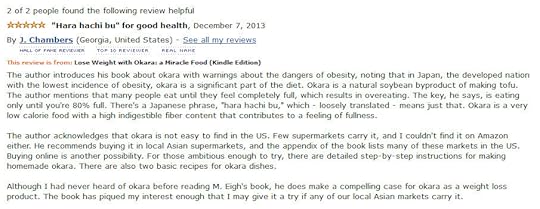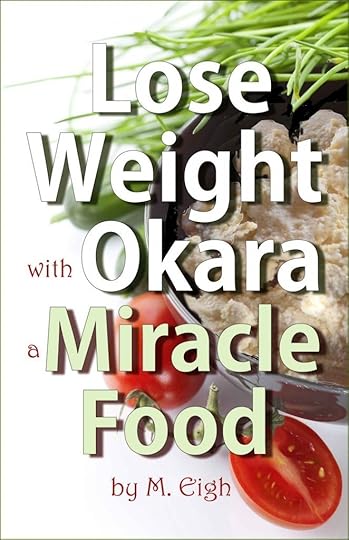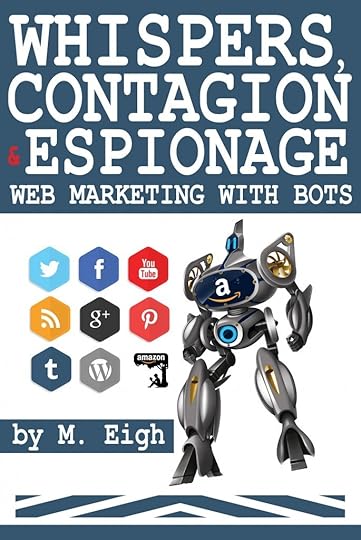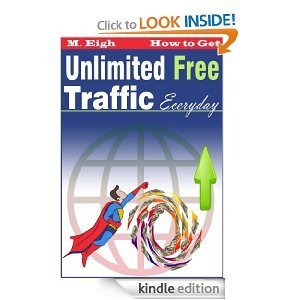M. Eigh's Blog, page 18
December 7, 2013
J. Chambers, an Amazon TOP 10 REVIEWER, gives “Lose Weight with Okara” a 5-star Review
J. Chambers, who wears Amazon HALL OF FAME REVIEWER, TOP 10 REVIEWER and REAL NAME badges, gives my new book Lose Weight with Okara: a Miracle Food a 5-star rating. J (short for Jim I believe) says, “Although I had never heard of okara before reading M. Eigh’s book, he does make a compelling case for okara as a weight loss product. The book has piqued my interest enough that I may give it a try if any of our local Asian markets carry it.”
You can read this Hall of Famer’s full review here: http://amzn.to/19qajzE.
December 5, 2013
99¢ Reviewer Copy: Lose Weight with Okara: a Miracle Food
Today only: you can grab a copy of Lose Weight with Okara: a Miracle Food for just 99¢ at http://amzn.to/1ecnloc, if you are interested in providing an honest review.
Here’s the gist of the book:
With this unique and entertaining book that’s part dietary advice, part travelogue, M. Eigh takes you on a journey to the fascinating corners of history, culture and science.
You will return with new wisdom on how to lose weight safely and a treasure map of how to arrive at good health with the help of an ancient yet newly available miracle food: okara.
Hara Hachi Bu Made Easy!
If you have tried hara haci bu before, you would know it is a torturous hunger game. Okara effectively takes the hunger game out of the equation. If you have not heard of hara hachi bu before, you have all the more reason to check out Lose Weight with Okara: a Miracle Food.
December 4, 2013
Hara Hachi Bu Made Easy with Okara
The inhabitants of Ryukyu archipelago, a.k.a. Okinawa Prefecture in Japan, are known for their congregation of centenarians. In addition to enjoying record-high longevity, Okinawans also enjoy an excptionally low cancer rate, especially in breast, colon, ovarian and prostate cancers.
In fact, Okinawa has become the mecca of medical and dietary researchers who seek to uncover the secrets to longevity and healthy living. Their investigation over the years have produced convincing evidence that the longevity and health Okinawans enjoy are attributable to their largely plant-based diet and – equally important – their social norm on eating.
That social norm, without a doubt, is the uncompromising disapproval for gluttony deeply rooted in the Japanese psyche. Evidence of this sentiment is ubiquitous in Japanese culture. It is generally held as self-evident that gluttony equals obesity. While here in the U.S. we cheer for gluttony on TV shows like Man vs. Food Nation and indulge ourselves in our own prime time competitive eating, it is not uncommon to hear a stranger in Japan deliver the unsolicited, cold and hard truth to you when he sees you eating too much: “たくさん食べると太るよ.” (“If you eat a lot, you will get fat, for sure.”)
In Hayao Miyazaki’s über-successful, Oscar-winning movie Spirited Away, the parents of Chihiro, the heroine, metamorphose into pigs after they engorge themselves on a free feast. In a typical Japanese dining, wealth and abundance is always displayed with variety, never that of quantity or portion.
Good advices, when spoken in Japanese, do not always sound critical. They can be, instead, constructive and philosophical. Have you ever heard of the Japanese saying “Hara hachi bu?”
If you haven’t, allow me to explain. “Hara hachi bu” is “stomach eight parts” when literally translated into English. It means “Quit eating when you are 80% full.”
I think you will agree with me and do not need me to belabor the point when I say that there is a great deal of wisdom in the principle of hara hachi bu. Countless laboratory experiments have also proved it true at least in the animal world: Mice and rats who have been deprived of one-third of their calorie intake appear to live about 35 percent longer than their peers who are allowed to eat their fill at each meal. A University of Wisconsin experiment on rhesus monkeys reveals a similar result.
If you have heard of hara hachi bu before, you are likely in agreement with its principle, but much less convinced of its practicality than when you first heard of it. In all fairness, eating only 80% of your fill is much easier said than done. First of all, extra servings are always there: if they are not on the table, they are in the pantry or in the fridge. Secondly, food is a predominant expression of sympathy or camaraderie in most cultures: your loving grandparents always remind you to eat; when you are homesick you eat; when you are lovesick you eat; you eat at a wedding and you eat at a funeral… There is even an alleged Jewish advice for the housewife: if your man is not horny, make him a sandwich. Alas, there is just no escaping when it comes to eating!
And biologically, it is perfectly normal for us to eat until we are stuffed. Scientific studies have long revealed that the brain has more to do with feeling full than your gut. Stretch receptors send “full” signals to the brain when the stomach is filled with food or water. But those signals alone won’t be enough to establish the pleasurable feeling of “full” in the brain. That threshold of pleasure and satiety is only crossed when hormones released by partially digested food enter the small intestines. The bottom line is: the feeling of fullness must come from two dimensions: quantitative and temporal. You must eat enough to fill the stretch receptors of the stomach. You also must give the stomach enough time to process the food. If you are a fast eater, chances are you have passed the point of satiety when you start to feel full.
Needless to say, when you are adopting hara hachi bu after a lifetime habit of eating to your stomach’s fill, you are voluntarily denying yourself the feeling of pleasure and satiety you are used to. In turn, that deprivation is naturally misinterpreted by your brain as hunger. As a result, if you are not a typical Okinawan who has exercised this regimen all his or her life, hara hachi bu basically becomes your personal “hunger game:” You’ll be living with a lingering feeling of hunger.
Such a hunger game is no fun when you live in a hedonistic and self-indulgent food culture such as the American one. It requires a tremendous amount of will-power to pull off hara hachi bu on a day-to-day basis. Your dinner companions are likely to have no appreciation for its noble principle. What’s worse is that you always have to stop eating just a few forkfuls short of feeling satisfied. Bummer.
That’s where okara comes in handy. By incorporating okara into your diet, you effectively take the hunger game out of hara hachi bu. Let okara fill the last 20% of your stomach capacity and let your brain receive the nerve signals of satisfaction it so craves, while your 80% calorie restriction holds its fort.
It appears to be working in Japan, the nation that eats the most okara; according to a recent report by the Food and Agriculture Organization of the United Nations (FAO,) Japan is the world’s thinnest developed country, with just 4.5% of adults considered obese.
It’s a win-win game plan. Find out its elegantly details in my new book: Lose Weight with Okara: a Miracle Food. Also available on Kindle. (Click on the following image to read the free sample chapters.)
The Calorie-Restriction Experiment (http://www.nytimes.com/2009/10/11/magazine/11Calories-t.html?pagewanted=all&_r=2&,) the New York Times Magazine, by Jon Gertner, October 7, 2009
The State of Food and Agriculture: Food Systems for Better Nutrition, 2013, at http://www.fao.org/docrep/018/i3300e/i3300e.pdf, FAO.
November 23, 2013
Books Have Side Effects Too!
Books Have Side Effects Too!
For example, side effects of reading my book Whispers, Contagion & Espionage: Web Marketing with Bots include a sudden surge of self-esteem and unprecedented decisiveness in making marketing decisions. Also common are a lifetime addiction to web automation and web data scraping.
After reading this book, if you spend more than 4 hours with web bots a day, call a therapist right away.
November 12, 2013
It Does Not Get Much Better than This
Here’s the deal: My book KDP’s Best-Kept Secret Revealed: How to Embed Videos and Widgets in Your Book Description has thirteen(13!) 5-star reviews on it; and tomorrow, Nov.13, it will be free for all to download!
Free period starts at 12:00 AM PST Wed. Nov.13.Do not miss it!

Free Book: KDP’s Best-Kept Secret Revealed: How to Embed Videos and Widgets in Your Book Description
November 10, 2013
As God Is My Witness, I Will Never Pay a Penny for Traffic Again!
FREE Download for All!
I want to drop you a quick note that my latest release, “How to Get Unlimited Free Traffic Everyday,” will be FREE for you to download on Amazon starting 12:00 AM PST Monday.
This book will be free for about 24 hours or a little short of that. I’ve also only sent out notice to my loyal followers. If you happen to be interested in the subject, please do not miss it. Regular price for the book is $2.99.
The book can be downloaded free at http://amzn.to/16UBftv. And feel free let your
firends and fellow Indie authors know about this free download. I’ve published it so that people who are still paying for traffic do not have to waste their money any more.
What’s the book about:
What’s your website’s daily pageview count like? Not completely satisfied, or not satisfied at all?
You’re not alone. Millions of quality websites out there are like spinsters sitting in the corners of singles’ party, pining for some attention. On the web, attention can only come in one form – traffic. That’s why a site is rated by search engines by its daily pageview count, among many other things.
This book teaches you how to roll up your sleeves and generate unlimited FREE traffic, with the help of a great bot you can download free, while many others are still dishing out their hard-earned money to pay for traffic.
You will be excited about the prospect of an improved search engine ranking after you read my book. But what’s revealed in this little book is just the tip of the iceberg. In the battlefield of web marking with web bots, what you learn in this book is a beginner’s game. If you are serious about web marketing and you mean it when you say you want to sell your books or other products on the web, you owe it to yourself to get a copy of my other book,
Whispers, Contagion & Espionage: Web Marketing with Bots.
P.S.: If you altready own Whispers, Contagion & Espionage: Web Marketing with Bots, it is not necessary to download this book.
Thank you for your attention!
M. Eigh
November 6, 2013
Amazon Has More Arrows in Its Quiver
If you ask me, I’d say Amazon moves like the Japanese Imperial Armed Forces in WWII. I do not intend such an allegory to foretell Amazon’s fortune. By this analogy, I mean to emphasize the preemptive nature of Amazon’s strikes against its enemies.
Last night (Nov. 6, 2013,) Amazon strikes again by driving a dagger into LightningSource’s chest, as it officially waives the $25 charge for Extended Distribution for paperbacks published on CreateSpace’s POD (Print on Demand) platform.
As such, Amazon officially makes the CreateSpace platform completely FREE. Free means zero risk for the large horde of Indies or self-publishers whose paperback titles are not really selling well or selling at all. Free gets people to think “Why the hell not?” Free steals more publishers from CreateSpace’s competitors such as LightningSource.
November 5, 2013
Amazon Makes CreateSpace Extended Distribution Free
As of Nov. 5, 2013, Amazon has dropped the price of CreateSpace Extended Distribution to $0.00.
That’s right. It’s free now.
When you log into your CreateSpace account, look for the alert banner as shown below:
Indies and self-publishers, sign all your babies up!

Amazon Makes CreateSpace Extended Distribution Free
If you actually do not know what this means, allow me to explain. Extended Distribution has been an option offered by CreateSpace at $25 per pop.
When you publish a paperback via CreateSpace, Amazon offers you three distribution channels free of charge. They are Amazon.com, Amazon Europe. CreateSpace eStore. These are pretty self-explanatory. When you elect to purchase the Extended Distribution, you will get three additional distribution channels: Bookstores and Online Retailers, Libraries & Academic Institutions, CreateSpace Direct.
Bookstores and Online Retailers include thousands of major online and offline bookstores and retailers. Your book automatically appears in major distributors catalog. For example, someone can browse Barnes & Noble and find your book.
Libraries & Academic Institutions include public libraries, elementary and secondary school libraries, and libraries at other academic institutions.
CreateSpace Direct makes it possible for your book to get in the hands of discount resellers who have engaged in partnership with CreateSpace. Amazon labeled them as certified resellers. They could be independent bookstores and book resellers. The CreateSpace Direct program allows eligible resellers to buy books at wholesale prices directly from CreateSpace. But when they discount your book’s price, you still get your preset royalty amount.
November 3, 2013
With Bookbub, Should I Do the Free or the 99¢?
So when you finally have a book likely to be accepted by Bookbub, should you choose to do the free give-away or the for-sale promotion (like the 99¢ discounted pricing)?
I get that question all the time. People over-think about strategy. Marketing is just like anything we do in life. There has to be an element of unknown. When a move carries a downside risk, it also intrinsically carries an upside risk.
With Bookbub, my vote is with the free choice. The Amazon algorithm is by “affiliation.” The more people download it when they do other things on Amazon, the greater the possibilities that more people may re-trace the same route to your book.
The “reading” part is irrelevant for mass marketing. Worry about that when you are doing target-marketing on GoodReads etc. People who download and never read will NEVER buy your book anyway. But when they download, they push up your book stats. God bless them. I wish there are a hundred thousand people download mine when it’s on promotion and never read. The stats influence the real target audience of your book.
I have two books on Kindle book marketing that you may find interesting:
Whispers, Contagion & Espionage: Web Marketing with Bots (Brand new, just out this morning.)
KDP’s Best-Kept Secret Revealed: How to Embed Videos and Widgets in Your Book Description (13 readers have given it 5-star so far.)
Both books contain a lot of secrets people who ask this typical Bookbub question may not know.
How to Sell Books with the Help of Web Bots
This one is fresh and hot from the oven. How to sell your books with the help of web bot.
Check it out everyone. You owe it to yourself to at least read the free sample: Whispers, Contagion & Espionage: Web Marketing with Bots








